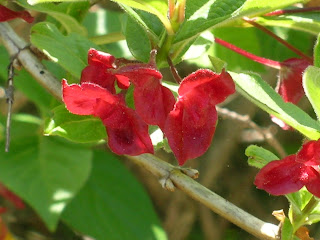

 Fuzzy Fragrant pink balls of tiny flowers on a short shrub. Then brownish seedheads that can be used in dried arrangements. Bronzy red fall color.
Fuzzy Fragrant pink balls of tiny flowers on a short shrub. Then brownish seedheads that can be used in dried arrangements. Bronzy red fall color.In bloom and for sale on the plant deck at the UC Botanical Garden now.





 Yesterday it warmed up and the butterflies came out. While I was looking for eggs in the front yard (to take to the old folks home, see previous post) I found this West Coast Lady on the mallow in my driveway. I put the plant in years ago and never expected it to survive, since I don't baby my plants. All I do is pull up the weeks occasionally. But it has done rather well between the concrete strips of my ribbon driveway. And I think it is great that this butterfly thought it was the perfect place for her offspring.
Yesterday it warmed up and the butterflies came out. While I was looking for eggs in the front yard (to take to the old folks home, see previous post) I found this West Coast Lady on the mallow in my driveway. I put the plant in years ago and never expected it to survive, since I don't baby my plants. All I do is pull up the weeks occasionally. But it has done rather well between the concrete strips of my ribbon driveway. And I think it is great that this butterfly thought it was the perfect place for her offspring.
 Today, Andy and I went out to Danville to give a butterfly presentation at an old folks home. The people were really sweet, they really enjoyed seeing all our specimens. It was a very pleasant spot. It had comfortable seating on the patio. Art made by the residents lined the walls. A huge aviary with beeping birds was being cleaned while we were there. And of course, they had a nice common room with a lovely tv for the presentation. Some people fell asleep soon after we started, but that was okay. Usually, we have people come up to the table to see specimens, but instead we walked the jars around the room. That seemed to work pretty well. After the presentation, we walked out to the garden and gave them some ideas about where to put butterfly plants. So it all went very smoothly, even though it was our first time at an old folks home. But I'm glad I don't live in Danville. It was hot!
Today, Andy and I went out to Danville to give a butterfly presentation at an old folks home. The people were really sweet, they really enjoyed seeing all our specimens. It was a very pleasant spot. It had comfortable seating on the patio. Art made by the residents lined the walls. A huge aviary with beeping birds was being cleaned while we were there. And of course, they had a nice common room with a lovely tv for the presentation. Some people fell asleep soon after we started, but that was okay. Usually, we have people come up to the table to see specimens, but instead we walked the jars around the room. That seemed to work pretty well. After the presentation, we walked out to the garden and gave them some ideas about where to put butterfly plants. So it all went very smoothly, even though it was our first time at an old folks home. But I'm glad I don't live in Danville. It was hot!



 I've got Gulf Fritillaries eating my Passiflora subpeltata "Berkeley." This variety of Passion Vine has white flowers with a lavender halo.
I've got Gulf Fritillaries eating my Passiflora subpeltata "Berkeley." This variety of Passion Vine has white flowers with a lavender halo.




 This plant is called for Heal-All and Self-Heal. Does it cure itself when it gets sick? I don't know. But I do know that it has been considered a panacea in many different cultures for a very long time. It has been used for pink eye, diarrhea, sore throat, internal bleeding and on and on. All parts are edible and can be eaten raw or cooked, although it is a bit bitter. Because of the taste, many herbivores don't eat it. But bees and butterflies use the nectar.
This plant is called for Heal-All and Self-Heal. Does it cure itself when it gets sick? I don't know. But I do know that it has been considered a panacea in many different cultures for a very long time. It has been used for pink eye, diarrhea, sore throat, internal bleeding and on and on. All parts are edible and can be eaten raw or cooked, although it is a bit bitter. Because of the taste, many herbivores don't eat it. But bees and butterflies use the nectar.



